Zambia Trip Inspiration
Speak to a Zambia expert today
and start planning your tailor-made holiday

Alistair

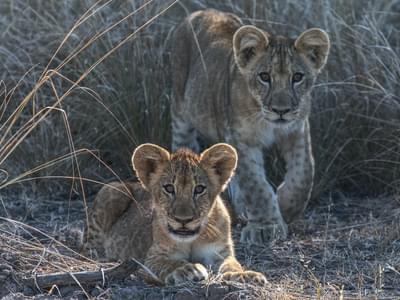
The Big 5. The epitome of safari, held high in your expectations as you make your long-awaited journey into the depths of Southern Africa after months of waiting. The wild animals we’ve all seen from the moment we’re born, in story books, science books, movies, on TV and in our dreams boil down to the five most renowned of African wildlife: the ferocious Lion; the majestic Elephant; the enigmatic Leopard; the boisterous Buffalo and the riotous Rhinoceros. While Africa hosts a bounty of other captivating creatures, the Big 5 will inevitably be secure on any safari goer’s checklist, whether it’s your first or fiftieth time. A neat number to check off one by one and satisfy the yearning - to see these magnificent beasts in the flesh and in the wild.
Read on to find out where to see the Big 5 as we dissect the best wildlife sanctuaries across the humble and wonderful Zambia.

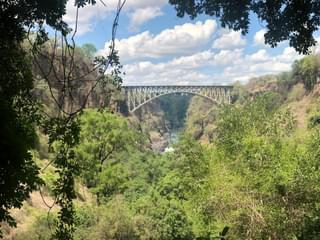
Our journey begins in the little town of Livingstone. Brimming with colonial history and charm, and home to the world-famous Victoria Falls. Situated on the border of Zambia to Zimbabwe, Livingstone boasts a fabulous little national park, named after the local moniker for the Falls, ‘Mosi oa Tunya’… ‘the Smoke that Thunders’. While humble in size, this park, established in 1972 and covering a mere 66km², is inhabited by a myriad of species including giraffe, waterbuck, impala, wildebeest, zebra, bushbuck, warthogs, monkeys, baboons, hippos, crocodiles and three of your Big 5 animals, migratory elephants, buffalo and the incredible white rhino which were introduced into the park in 1994, making it the only place in Zambia to find white rhino.
The park stretches 12km along the banks of the Zambezi River, just downstream from Victoria Falls, so visitors to the area can enjoy a comprehensive stay making the most of a wide range of water, land-based and safari activities. Many accommodation options offer in-house excursion options to visit the Falls and Zambezi River, as well as the opportunity to view the area’s wildlife.
While game drives are a given in most national parks and are a great way to experience the wilderness and wildlife, Mosi oa Tunya also hosts fantastic walking safaris designed to give you an up-close encounter with the animals and bush around you. The most sought-after activity is the rhino tracking walks which guarantee you a view of the ‘near threatened’ white rhino of which there are only just over 10,000 left in the world. Upon meeting your guide, you will be transported into the bush by vehicle and dropped in the vicinity of the rhinos with a trained ranger for your safety. Along with your guide, you will hone your senses and learn the skills of animal tracking. Identifying their foot tracks, where they have been feeding, locating scat and deducing their location from these indicators. Once located you will spend quality time watching and photographing the beautiful rhinos, peacefully observing their graceful nature while your guide regales you with stories and facts about the flora and fauna surrounding you.
Where to stay: Thorntree River Lodge; Sanctuary’s Sussi & Chuma; Tongabezi; Royal Chundu



Moving down the river into eastern Zambia, we find ourselves in the Lower Zambezi National Park where we’re upping the ante and ticking off four of our Big 5 species. Spanning a much grander 4092 km² and, as the name suggests, set upon the banks of the lower end of the Zambezi River, the park overlooks Mana Pools National Park in Zimbabwe across the wide stretch of water, forming a major sanctuary for wildlife in the area who cross freely between parks when the water levels are low.
Visually stunning, the landscape of the area is littered with magnificent ebony and winter thorn forests, attracting huge numbers of the great African elephants. Watch as they swim and frolic in the water and enjoy a buffet of protein-rich winter thorn pods and leaves throughout the area and even within the camp. The silent behemoths flit between the northern mountain range in the rainy season and come down in droves to the riverside in the dry season where you can see literally hundreds of them throughout the park.
While elephants are the most prolific member of the Big 5 to be found here, Lower Zambezi is also home to buffalo, lion and leopard; as well as a bonus species, the African wild dog. There is a healthy population of lions and leopards in the park, offering a great opportunity for you to see them. View these creatures on a scenic game drive, venturing deep into the park to uncover its best-kept secrets; or get stuck into the details with a guided walking safari. Another activity, which calls upon the more adventurous safari-goer is the canoe safaris. Hop into your canoe along with a guide and paddle your way downstream observing the water-based wildlife up close, as well as the elephants that come down to the river to drink, bathe and feed. Watch them as you drift silently by, the gentle rustle and munching, and the sounds of the birds and buzz of life bush whispering in your ear.
Where to stay: Baine’s River Camp; Old Mondoro; Chiawa Camp; Sausage Tree Camp
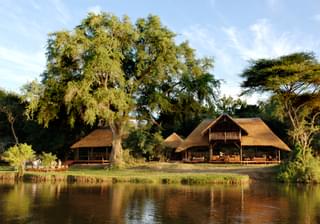


Our last stop on this journey had to be the holy grail of safari destinations in this part of the world: the Luangwa Valley. Technically split into two separate parks and established in 1972, North and South Luangwa are 4,636km² and 9,050km² in size respectively.
Widely considered one of the greatest wildlife sanctuaries in the world South Luangwa boasts extraordinary concentrations of wildlife with species including lion, leopard, buffalo, elephant, wild dog, hyena, crocodiles, hippos, warthogs, porcupine, over 400 species of birds as well as three animal species that are endemic to the Luangwa, the Crawshay’s Zebra, Cookson’s Wildebeest and Thornicroft Giraffe. Its most famous resident however is the African leopard. The area is commonly known as the ‘Valley of Leopards’ given the abundance and healthy population density of these exquisite and elusive cats. They say there is no better place on earth than South Luangwa National Park to ensure at least one sighting of the sleek and mighty leopard. Game drives and walking safaris alike are a splendid way to see all the wildlife, and if you’re staying inside the park, watch and wait from a sun lounger on the deck as wild animals pass freely in front of, and through the camp, feeding from the surrounding trees, having a sip of water from the swimming pool or simply dozing in the shade of a chalet.
To check off that final member of the Big 5, you will need to venture northwards by game vehicle or plane into North Luangwa. Here you will be greeted by a very different landscape and experience. Devoted to walking safaris, enjoy a rustic and unique stay in a truly wild and untouched haven. Thanks to supreme conservation efforts, the latest additions to the North Luangwa family are a number of critically endangered black rhino.
If you are coming off a white rhino walk in Mosi oa Tunya, you may notice a few visible differences to the black rhino; and no, it’s not their colour! Apart from their sizes (the black rhino being smaller and more agile), you will find that as a ‘grazer’ of grasses and other low-lying flora, a white rhino’s head is held down low, with their mouths brushing along the ground as they walk. They also have a squared lip, allowing them to efficiently take in more nutritional grasses and stems with each bite. Black rhinos are ‘browsers’ of bushes and shrubbery and so their heads sit slightly more elevated; they have a hooked lip, helping them to grab and tear small leaves and twigs off shrubs and bushes with ease and helping to avoid any nasty thorns!
Historically, black rhinos were found in North Luangwa but sadly they were completely poached out of the area in the 90s. After having been declared officially extinct in Zambia in 1998, North Luangwa Conservation Programme reintroduced 25 black rhinos into North Luangwa in four separate relocation efforts between the years 2003 and 2010, making the area the only place in Zambia to find the black rhino. As of 2019 the population of black rhino in the world was estimated at just 5,000 animals but thanks to the amazing conservationists across southern Africa, this number is slowly increasing.
Want to experience the Luangwa Valley? Check out these epic accommodation options:
South Luangwa
North Luangwa
Trip idea: experience Victoria Falls, Lower Zambezi and Luangwa in this fabulous tour to tick off your Big 5 bucket list: Classic Zambia Safari.
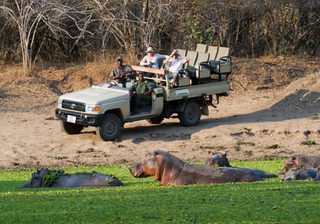
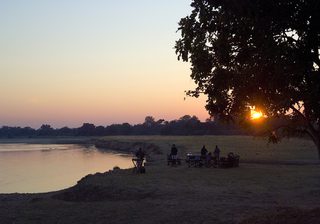
Kafue National Park – 4 of the Big 5
Zambia’s largest national park, Kafue spans an epic 22,400km² and is a relatively short drive from Zambia’s capital, Lusaka. The park surrounds the mighty Kafue River and Itezhi-tezhi dam, and boasts prolific wildlife including lions, leopards, elephants, buffalo, wild dogs, cheetahs, wildebeest and red lechwe.
Kafue is a great spot to start or end your tour given its vicinity to Lusaka and offers the opportunity for a magical boat safari on the river to see the animals from a different perspective as well as sunset cruises and fishing in the dam. For an even more unique experience, venture to the northern part of the park into the Busanga Plains and spot the wildlife and scenery from the air in a hot air balloon.
Where to stay: Ila Safari Lodge; Musekese Camp; Busanga Bush Camp; Kaingu Safari Lodge.

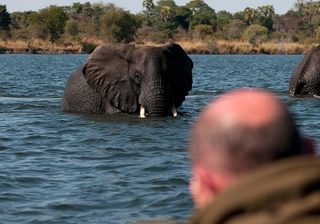
Liuwa National Park – 1 of the Big 5
The Liuwa Plains is the origin of the famous story of Lady Liuwa, ‘the last lioness’ who lived alone and thrived in the Liuwa National Park for several years after the rest of her species were poached from the area. Thanks to conservation efforts, more lions were introduced into Liuwa, giving her a new family to be a part of. The species has since thrived and the lions of Liuwa are plentiful once more. Although you won’t find any other members of the Big 5 here this breathtaking park is famous for being host to the world’s second-biggest wildebeest migration. You can also find wild dog and even some migratory cheetah.
A bit out of the way and without the big wildlife numbers of some of the other parks, Liuwa offers an exclusive stay suited for the more seasoned safari goer. With only one camp in the whole 3660 km² expanse of the park, you are sure to have a truly off the beaten track experience with this whole piece of absolutely breathtaking wilderness all to yourselves.
Where to stay: King Lewanika Camp.
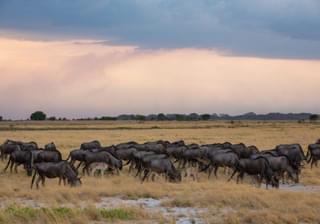
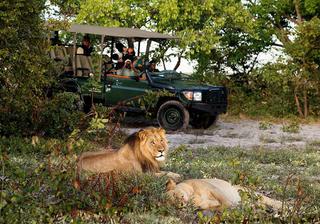
If you’re considering an African safari and the Big 5 are on your list, Zambia is a spectacular destination for you. Offering diverse landscapes and activities as well as a rich culture and the friendliest people around. Still remarkably unspoiled, Zambia offers a true African wilderness experience without the throng of crowds and hundreds of game vehicles at one sighting but provides a wholesome and authentic holiday for absolutely any traveller.
Don’t let its size intimidate you! Over the years we have perfected our knowledge and scoped out the very best destinations, lodges and logistics for fail-safe and easy itinerary building suited to you and your wishes.
Contact us to find out more about these glorious destinations and let us create a tour that will tick these five beautiful beasts and more off your bucket list.

and start planning your tailor-made holiday

